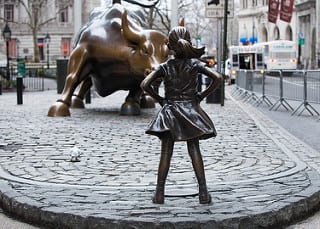“Men who don’t like women taking up space [is] exactly why we need the Fearless Girl.”[1] This is the tweet New York Mayor Bill de Blasio broadcasted in response to sculptor Arturo Di Modica calling for the statue’s removal.[2] State Street Global Advisors installed the Fearless Girl across from the famed Charging Bull statue on the eve of International Women’s Day to call attention to the gender pay gap and “dearth of women on the boards of the largest U.S. corporations.”[3] Indeed, twenty five percent of the largest 3,000 U.S. companies have no female directors.[4]
The Fearless Girl, standing four feet tall and defiantly facing the Charging Bull, has been posited as fundamentally corrupting the artistic integrity of the Bull.[5] The Charging Bull’s sculptor, Arturo Di Modica, claims the Fearless Girl violates his trademark, copyright, and moral rights as an artist.[6] Each of these claims, if pursued however, will be unlikely to pass muster in today’s statutory framework of intellectual property protection.
Although Di Modica’s attorney claims the confrontational posture of the two statues constitutes a commercial use of the Charging Bull in violation of trademark rights,[7] NYU Law Professor Amy Adler finds otherwise. She points to the Supreme Court’s reasoning in Pleasant Grove City v. Summum where Justice Alito reflected on the changed understanding of the Statue of Liberty over time.[8] Because it is unclear whether any one meaning can be ascribed to the Charging Bull, in addition to the inevitability of artistic meaning changing over time, a trademark suit may be unavailing.
Moreover, artists’ ‘moral’ rights are weakly protected in the United States. “The French concept of an artist’s moral rights, or droit moral, aims to protect the special relationship between a created work and its creator, sometimes referred to as an artist’s soul.”[9] This concept was codified in the Visual Artist Protection Act (“VARA”), which allows artists to “prevent any intentional distortion, mutilation, or other modification of that work which would be prejudicial to his or her honor or reputation.”[10] As an initial matter, the law only applies to works created after its 1990 passage, unless the artist did not transfer the title, so Di Modica may not be able to even invoke VARA.[11] Alternatively, it again may be difficult for him to prove a changed message as a result of the Fearless Girl that would constitute an intentional “mutilation” within the meaning of VARA. This is particularly true when State Street spokeswoman Anne McNally has stated “Our goal with ‘Fearless Girl’ was to create a powerful symbol to stand as a reminder to corporations across the globe that having more women in leadership positions contributes to overall performance and strengthens our economy.”[12]
In response to its sensational social media and press attention, New York City has extended the Fearless Girl’s installation permit through 2018.[13] To date, Di Modica has not formally filed a lawsuit but his prospects for success on the merits appears weak. In a time where environment influences cultural understandings of art, the Fearless Girl has been regarded as embodying the equal footing that men and women should share, both inside and outside the boardroom.

